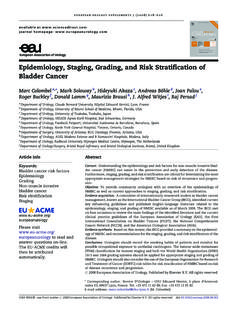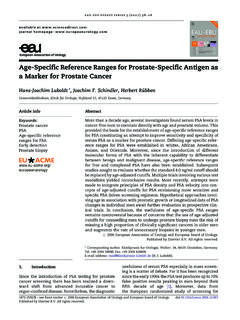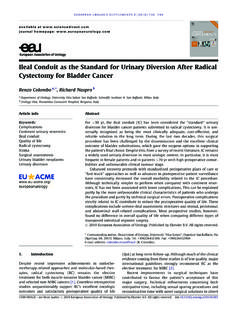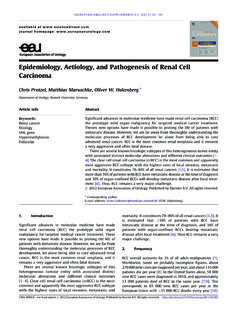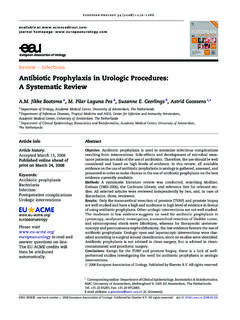Transcription of Treatment Strategies of Ureteral Stones - EU-ACME
1 Eau-ebu update series 4 (2006) 184 190. available at journal homepage: Treatment Strategies of Ureteral Stones Stefanos Papadoukakis a, Jens-Uwe Stolzenburg b, Michael C. Truss a,*. a Department of Urology, Klinikum Dortmund, Dortmund, Germany b Department of Urology, University of Leipzig, Leipzig, Germany Article info Abstract Keywords: Urinary stone disease is a major health care problem due to its high Urolithiasis prevalence and incidence. There are different therapeutic approaches Ureteral Stones for Ureteral Stones depending on stone size, location and anatomical Ureteroscopy variations of the urogenital tract. Watchful waiting with concomitant Lithotripsy medication ( , analgetics, anti-inflammatory agents, alpha-blockers) is considered an option for smaller Stones (<6 mm) that have a high probability for spontaneous passage.
2 Extracorporeal shock wave litho- tripsy is a minimally invasive therapeutic approach which has been widely used through the past 20 years. It is a standardized procedure which results in stone free rates between 59% and 100% depending on the size and the location of the stone as well as the type of the litho- triptor. However, more than one session are frequently needed and Ureteral stenting is still a matter of debate. Ureteroscopy results in stone free rates of almost 95% in a single session. Stone removal may be achieved with forceps and baskets and with or without intraureteral stone disintegration with various lithotripsy devices. Treatment approaches should be individualized in order to achieve optimum out- comes.
3 # 2006 European Association of Urology and European Board of Urology. Published by Elsevier All rights reserved. * Corresponding author. Department of Urology, Klinikum Dortmund gGmbH, Mu nsterstr. 240, D-44145 Dortmund. Tel. +49 231 953 18700; Fax: +49 231 953 18790. E-mail address: ( Truss). 1. Introduction, epidemiology and stone among men and women with estimated prevalence composition among the population of 2 3% and an estimated lifetime risk of 12% for white males [1] and 5 6% for Urinary Stones are the third most common affliction white females [2]. The life time recurrence rate is of the urinary tract, exceeded only by urinary tract approximately 50% [3]. The interval between recur- infections and pathologic conditions of the prostate rences is variable, with approximately 10% within (BPH and prostate cancer).
4 Stone disease has been a one year, 35% within five years, and 50% within 10. major problem afflicting human population ever years [2]. The increased incidence of urinary Stones since the antiquity. Early reports of the disease can in the industrialized world is associated with be found in the Aphorisms of Hipparchos and even in improved standards of living (mainly including the Hippocrates. The disease is both very common high dietary intake of proteins and minerals) as well 1871-2592/$ see front matter # 2006 European Association of Urology and European Board of Urology. Published by Elsevier All rights reserved. eau-ebu update series 4 (2006) 184 190 185. as with race, ethnicity and region of residence [4].
5 A Table 1 Stone size, location and spontaneous passage rate [10,13]. seasonal variation is also seen, with high urinary calcium oxalate saturation in men during summer Stone size, location Stone passage rate and in women during early winter [5]. Stones form <4 mm 80%. twice as often in men as in women. The peak age in <7 mm proximal ureter 25%. men is 30 years; women have a bimodal age <7 mm mid ureter 45%. distribution, with peaks at 35 and 55 years. <7 mm distal ureter 70%. The composition of the urinary Stones can vary considerably (calcium oxalate, calcium phosphate, uric acid, ammonium urate, sodium urate, magne- The Treatment strategy of watchful waiting with sium ammonium phosphate, carbonate apatite, ultrasound follow-up is an appealing and efficacious cystine, xanthine, sulphonamide and indinavir approach for Ureteral Stones with a diameter of Stones ).
6 7 mm. Ureteral Stones of less than 4 mm in Many theories have been proposed for the patho- diameter have a chance of over 80% to pass genesis of urolithiasis, including nucleation theory, spontaneously [9]. the crystal inhibitor theory or even the crystal On the contrary, most Stones with a diameter retention theory. Moreover there are a number of >8 mm will ultimately necessitate intervention. The diseases associated with stone formation ( , hyper- spontaneous passage rate depends on the stone parathyroidism, renal tubular acidosis, cystinuria, burden as well as its location. The overall passage hyperoxaluria, intestinal malabsorptive conditions) rate is 25% for the proximal ureter Stones , 45% for as well as medications ( , calcium supplements, the mid ureter Stones and 70% for the distal ureter vitamin D, triamterene, indinavir).
7 Predisposing Stones , provided that the mean diameter does not factors for stone formation also include anatomical exceed 7 mm (Table 1). abnormalities ( , Ureteral strictures, vesico- Ureteral Time to spontaneous passage also depends on reflux, ureteropelvic stenosis, extrinsic Ureteral stone size and location. In one study the mean compression and ureterocele among others). passage time was between 5 days (for smaller distal Most of the urinary Stones pass through the renal Stones ) and 59 days (for larger proximal Stones ) [10]. calyces to the pelvis and subsequently to the ureter. Therefore conservative management within a Primary stone formation in the ureter requires an watchful waiting strategy of 4 to 6 weeks may be already existing obstructed urinary flow.
8 Despite an reasonable for smaller distal Stones if the patient improved understanding of the mechanisms of remains asymptomatic. However the presence of an stone formation it is obvious that Ureteral Stones acute infection, the decreased renal function or the are still a problem afflicting an increasing number of persistence of the symptoms despite the analgesic patients worldwide. Advances in technology have therapy could be among the contraindications for led to a wide armamentarium for the Treatment of such an approach (Table 2). the urinary Stones . Recently a number of studies investigated the effect of various drugs on spontaneous stone expulsion of distal Ureteral Stones . These drugs 2. Watchful waiting included analgetics, anti-inflammatory drugs, cal- cium antagonists such as nifedipine and alpha- The initial step of any adequate management of the blockers such as tamsulosin.
9 Of the above men- Ureteral Stones should be considered the relief of tioned agents tamsulosin seems to be especially pain. Pain relief may be achieved by the adminis- promising in preliminary studies [11]. tration of various agents through different routes. Diclofenac sodium, indomethacine, ibuprofen, methamizol, tramadol, pentazocine and hydromor- phone with atropine sulphate are among the most Table 2 Contraindications for watchful waiting approach [13]. frequently used agents. Comparative studies between diclofenac and other agents proved diclo- Containdications for watchful waiting approach of fenac to be superior to narcotic analgetics [6] Ureteral Stones (showing fewer side effects), while on the other Stone diameter >7 mm hand showed no difference compared to Ketoprofen Inadequate pain relief [7].
10 Moreover it has been speculated that diclofenac Concomitant infection Risk of pyonephrosis or sepsis may be able to prevent recurrent episodes of renal Bilateral obstruction, or unilateral obstruction in single kidneys colic if given on a regular basis (50 mg ) [8]. 186 eau-ebu update series 4 (2006) 184 190. 3. Extracorporeal shock wave lithotripsy situ without a stent. Interestingly, complication and (ESWL) retreatment rates were not affected by Ureteral stents [14]. ESWL has been established as a major therapeutic The introduction of the 2nd generation lithotrip- and minimally invasive option for the Treatment of tors that use electro hydraulic energy has improved renal Stones the last twenty years. Initially, there single session stone free rates.
